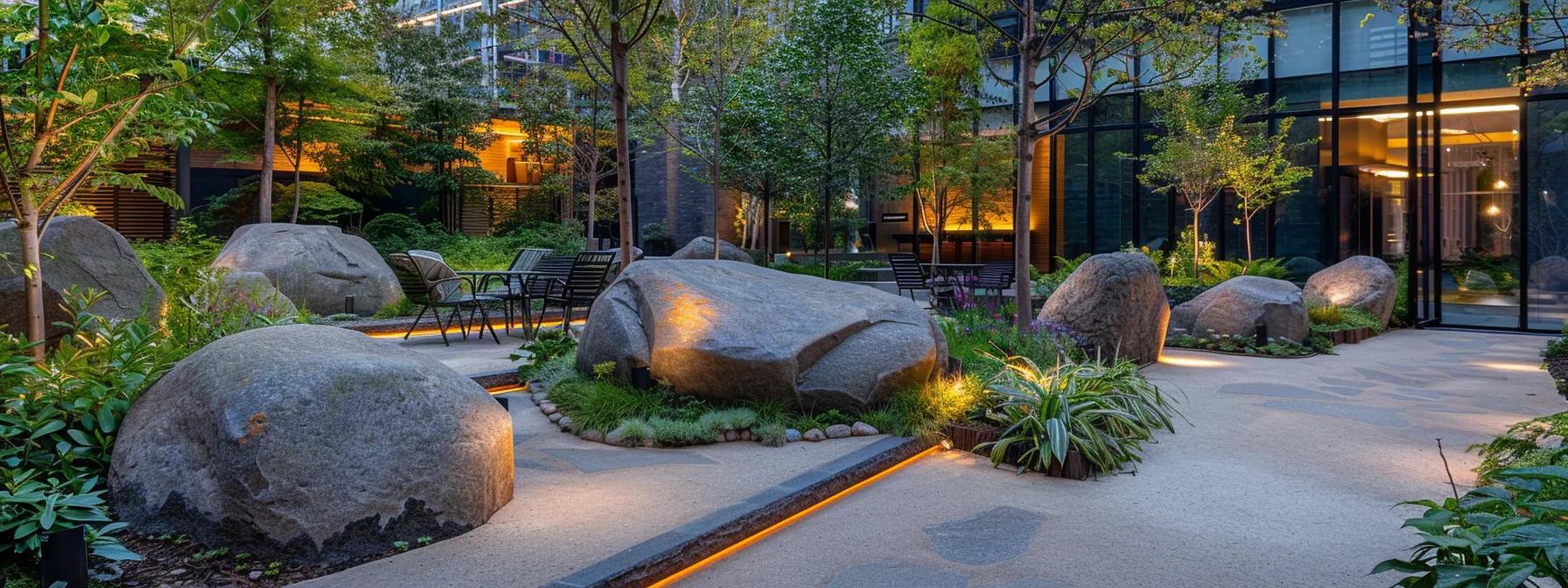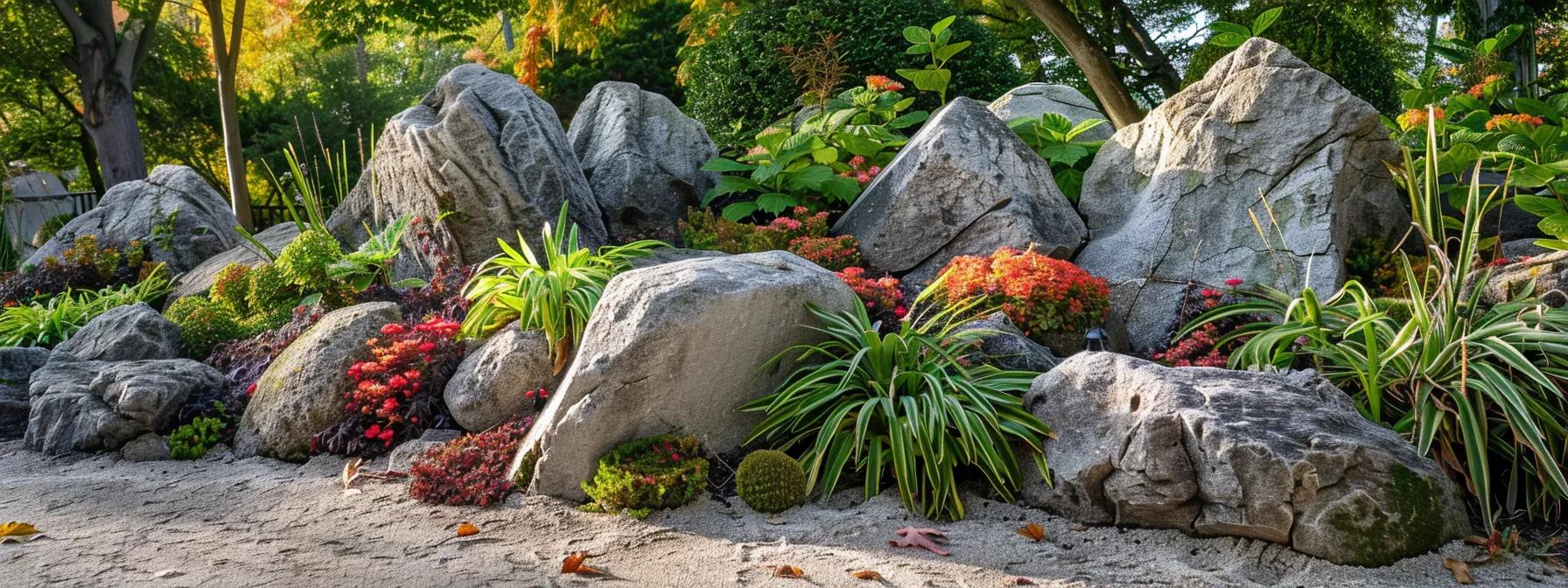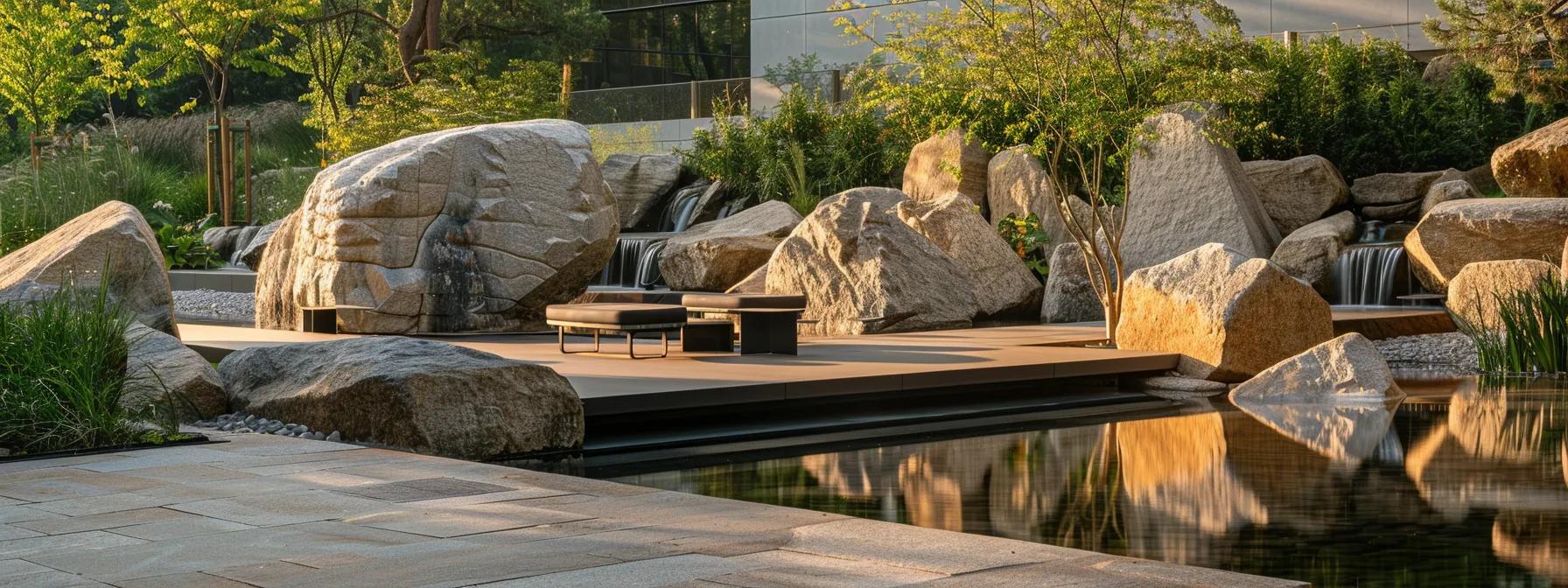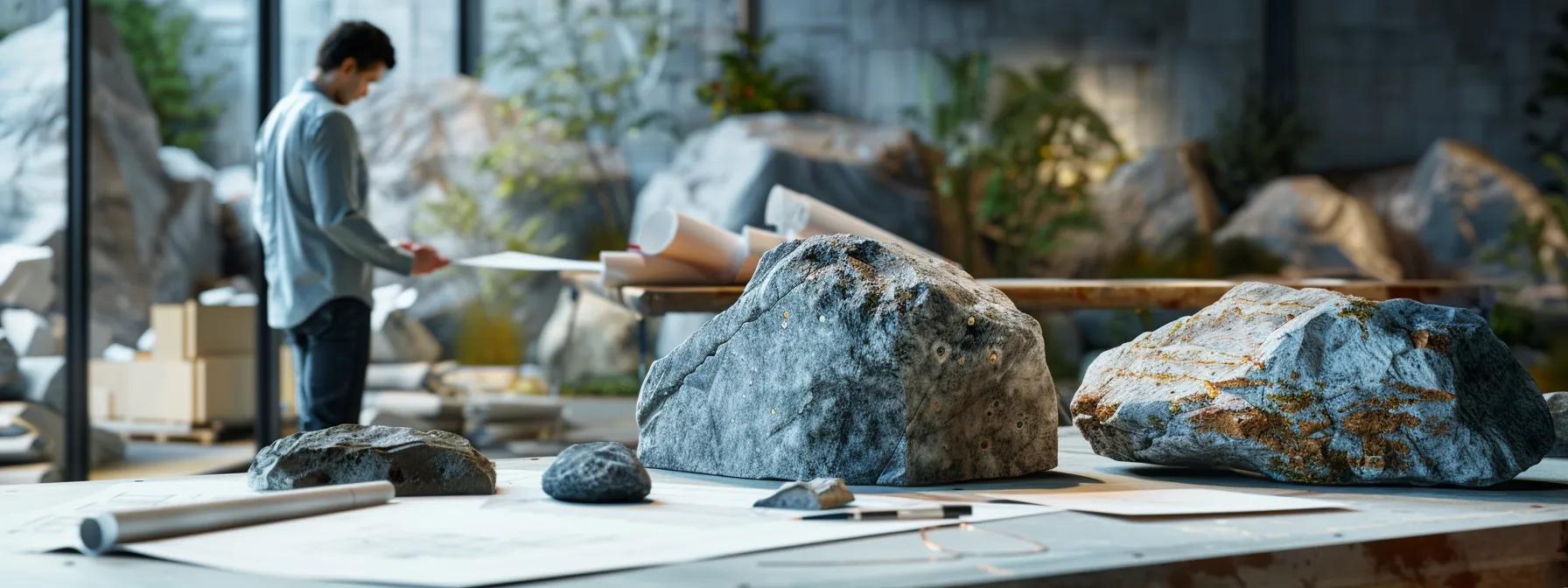Welcome to our Blog
The Brainerd Boulders Blog

Revamp Your Outdoor Space With Large Boulder Landscaping
5 Creative Ways to Use Large Boulders for Landscaping Solutions: Ideas and Practical Guides
An inspired landscape can transform any outdoor area into a striking visual experience while providing functionality and natural beauty. Homeowners and commercial property managers alike are increasingly looking for creative ways to integrate large boulders for landscaping into their designs.
The use of natural boulders in landscaping not only enhances aesthetic appeal but also addresses practical concerns such as drainage, erosion control, and low-maintenance design. This guide outlines creative and practical ways to use boulders – from rock gardens and retaining walls to water features and unique pathways. These ideas are particularly valuable in the Central Minnesota and northern Twin Cities metro area, where Pine Ridge Lawn& Landscape has long delivered dependable outdoor transformation.
Transitioning into specific creative strategies, the following sections detail various retaining wall landscaping ideas while addressing common queries and practical implementation techniques.
What Are the Best Boulder Landscaping Ideas for Enhancing Your Outdoor Space?
Large patio stones and boulders have a transformative power that instantly elevates the outdoor environment. Their irregular form and substantial size lend permanence and strength to a landscape. Used as focal points, boulders add texture and contrast amid softer plantings, break up extensive lawns, and guide integrated hardscape design.
How Do Large Boulders Transform Garden Design and Aesthetics?
Boulders introduce natural artistry into garden designs by creating striking visual breaks. Placing a boulder among flower beds or near water features draws attention while the rough texture contrasts with delicate foliage. This interplay between hardscape and softscape produces a balanced and dynamic design.
Which Boulder Types Are Ideal for Different Landscaping Styles?
Modern gardens benefit from sleek granite or bluestone boulders that offer a refined look and clean lines. In contrast, rustic designs favor limestone and fieldstone for their natural appearance. Gardeners aiming for a traditional rock garden might opt for boulders with smooth surfaces and varied coloration that seamlessly integrate with the overall theme. Additionally, incorporating a retaining wall can enhance the landscape's structure and functionality.
What Are the Environmental Benefits of Using Natural Boulders?
Natural boulders help control erosion by slowing water runoff and stabilizing soil. They also aid in water filtration by directing flow through garden beds. Being a natural material, boulders reduce the need for chemicals and excessive maintenance, resulting in a lower carbon footprint when sourced locally.
How Can You Create Stunning Rock Gardens Using Large Boulders?

Rock gardens create picturesque escapes that balance the bold presence of stones with carefully selected plants. In these gardens, boulders act as visual anchors and support functional benefits, including improved drainage and enhanced soil structure. Their strategic arrangement can form natural seating areas or pathways that wind through the garden.
What Are the Key Steps to Designing a Rock Garden With Boulders?
Begin with assessing natural contours and drainage patterns to determine optimal boulders for landscaping placement. Select boulders that vary in size and texture and arrange them in layers with larger boulders as centerpieces flanked by smaller stones as accents. Finally, integrate hardy plant species that thrive in rocky conditions to promote a low-maintenance and balanced design.
How Do You Choose the Right Boulders for Rock Garden Stability and Style?
Choose boulders based on aesthetic qualities—such as natural shape and color—and functional criteria like mass and stability to withstand harsh weather. Natural ledges and indentations in boulders can offer niches for plants. Locally sourced boulders for landscaping often integrate better with the regional landscape and support local ecosystems.
What Maintenance Is Required for Boulder Rock Gardens?
Rock gardens are low maintenance, yet they require periodic tidying. Regular removal of debris, checking the stability of stones, and monitoring plant health are essential. Occasional repositioning of shifted boulders and controlling weeds by manual removal or selective herbicides help preserve the design’s integrity.
What Are Effective Ways to Build Retaining Walls With Large Boulders?
Boulder retaining walls provide both aesthetic and practical benefits, including erosion prevention and soil stabilization. They are essential on hilly terrains or around basements to create level areas for gardens, patios, or gravel .
How Do Retaining Walls Using Boulders Prevent Erosion and Soil Loss?
Boulder walls slow water flow, reducing runoff speed and thereby preventing soil loss. By creating terraces, these walls help retain topsoil. Proper gaps between irregular boulders also facilitate drainage while maintaining infrastructure .
What Construction Techniques Ensure Durable Boulder Retaining Walls?
Start with a well-compacted gravel or crushed stone foundation. Arrange the boulders in a staggered pattern to avoid weak vertical seams. In some cases, adding mortar or geogrid reinforcement enhances stability. Ensuring proper drainage behind the retaining wall prevents water buildup that may compromise structural integrity.
Which Boulder Types Work Best for Retaining Wall Projects?
For durability, granite and limestone boulders are popular because of their hardness and resistance to weathering. Fieldstone boulders are favored for their rustic interlocking properties, while bluestone offers a refined look. The choice should balance aesthetic compatibility with functional longevity. Large boulders for landscaping are often considered for those seeking significant visual impact.
How Can Boulders Be Incorporated Into Water Features and Garden Elements?

Incorporating boulders into water features enhances both beauty and function. They can shape ponds, waterfalls, and streams while directing water flow naturally. Boulders create barriers that add an organic quality to water displays and can also serve as planters or seating areas.
What Are Popular Boulder Water Feature Designs?
Cascading waterfalls often employ a series of boulders at varying heights, creating a natural, flowing effect. Artificial streams benefit from boulders that carve natural curves, and rock pools formed by large boulders for landscaping arrangements can improve water filtration and create mini-habitats for aquatic plants.
How Do You Integrate Boulders With Plants and Water for Natural Appeal?
Position boulders along the edges of water features to create a contrast with flowing water. Complement this with moisture-loving and native plants to create a seamless transition between hardscape and softscape. This integration produces a naturally balanced and low-maintenance design.
What Are the Installation Considerations for Boulder Water Features?
Ensure a stable, level foundation for both the boulders and the water basin. Use waterproofing measures such as pond liners to avoid leaks. An efficient pump and filtration system are crucial to maintain water clarity. Finally, arrange boulders to allow natural water flow and prevent obstructions with gravel.
How Can You Use Large Boulders to Create Unique Pathways and Decorative Elements?
Boulders can create unique pathways and decorative accents that add rugged charm to any landscape. Boulder pathways provide a durable, low-maintenance route, while decorative boulders serve as natural art pieces and markers for different garden zones.
What Are the Steps to Build a Boulder Pathway in Your Yard?
Mark the intended path and level the surface. Excavate a shallow trench, add a layer of crushed stone for drainage, and compact it. Place boulders evenly along the path, fill any gaps with sand and gravel to secure them, and finish with decorative edging to blend the pathway into the concrete landscape.
How Do Decorative Boulder Elements Enhance Landscape Character?
Decorative boulders work as natural sculptures that draw the eye. Their organic shapes and textures create contrast with uniform garden areas and add personality. Whether used alone or in groups, these elements enhance overall garden continuity and style.
What DIY Tips Help Safely Move and Place Large Boulders?
When moving boulders, always use appropriate lifting equipment such as dollies or mechanical lifts. Enlist help for heavy stones, and wear protective gloves and sturdy footwear. Plan the final position and test for stability before final placement to avoid injuries and ensure secure installation.
How Do You Choose the Right Large Boulders for Your Landscaping Project?

Choosing the right boulders is critical for both design and functionality. Consider size, type, cost, and local availability to ensure the boulders complement the design and meet structural requirements like drainage and erosion control. Local sourcing often offers a sustainable and cost-effective option for large boulders for landscaping.
What Factors Affect Boulder Selection: Size, Type, and Cost?
Larger boulders offer greater stability and impact but should be proportional to the space. The boulder's type—whether granite, limestone, or fieldstone—affects both its durability and aesthetic appearance. Cost must be balanced with quality, with local suppliers often offering economical choices without compromising on durability.
Where Can You Source Sustainable and Local Landscaping Boulders?
Local quarries, stone yards, and landscaping supply companies are the best sources for sustainable boulders. These local options generally provide stones with minimal transportation impact. Many vendors offer boulders specifically graded for landscaping to ensure durability and visual appeal.
How Does Boulder Placement Affect Drainage and Soil Health?
Strategically placed boulders can channel water to reduce pooling and encourage even moisture distribution, which supports healthy soil and deep root growth. Poor placement, however, can lead to waterlogging or erosion. It is crucial to plan drainage routes carefully and space boulders appropriately for optimal soil health.
What Are the Benefits of Professional Boulder Landscaping Design and Installation?
While many homeowners undertake DIY projects, professional boulder landscaping offers superior long-term success. Experts ensure that boulders are selected, placed, and maintained with precision, addressing drainage and structural concerns to minimize future repairs. Professional design also significantly enhances property value through improved curb appeal and unified aesthetics, including a large boulders for landscaping.
How Does Expert Boulder Placement Improve Longevity and Aesthetics?
Professionals use their in-depth understanding of design and environmental factors to place boulders optimally. They consider sun exposure, soil conditions, and climate to ensure longevity and enhance visual appeal. Their expertise results in a resilient design that requires less maintenance over time.
What Sustainable Practices Do Professionals Use in Boulder Landscaping?
Professionals often source local boulders and pair them with native, low-maintenance plants to reduce environmental impact. They design eco-friendly drainage systems and use minimal chemical treatments, ensuring that the landscaping remains both sustainable and cost-effective in the long term, with large boulders for landscaping.
How Can Custom Boulder Landscaping Increase Property Value?
Custom boulder landscaping creates unique outdoor living spaces that stand out to potential buyers. These features improve structural elements like retaining walls and pathways, adding functional as well as aesthetic value. The result is a higher property value and enhanced market appeal.
5 Key Advantages of Incorporating Large Boulders into Landscaping
Enhanced Aesthetics – Natural Focal Points Boulders provide dramatic focal points that add texture and contrast, transforming ordinary spaces into visually engaging environments.
Erosion Control – Stability and Drainage Their weight and size make boulders effective at reducing water runoff and preventing soil erosion, stabilizing slopes over time.
Low Maintenance – Sustainability and Durability Once installed, boulders require minimal upkeep compared to more delicate materials, offering enduring beauty with periodic cleaning.
Functional Hardscaping – Versatile Design Applications Boulders are used to form pathways, retaining walls, and water features, serving both practical and decorative purposes.
Environmental Benefits – Eco-Friendly and Local Sourcing When sourced locally, boulders reduce environmental impact by minimizing transportation and chemical use while supporting natural drainage.
Frequently Asked Questions
Q: How do large boulders improve the overall landscape design? A: They serve as natural focal points that create visual interest and contrast with plants and lawns, adding stability and enhancing design functionality, large boulders for landscaping.
Q: Can large boulders be used in both modern and rustic landscaping styles? A: Yes. Modern designs favor sleek granite or bluestone, while rustic settings benefit from natural fieldstone and limestone, making boulders for landscaping highly versatile.
Q: Do boulder retaining walls require professional installation? A: Although DIY options exist, professional installation is recommended to ensure proper leveling, drainage, and long-term structural stability with large boulders for landscaping.
Q: How can the addition of boulders increase property value? A: Custom boulder landscaping enhances curb appeal by adding unique visuals and structural improvements, which help properties stand out in the market.
Q: Are there any environmental benefits to using natural boulders in landscaping? A: Absolutely. Boulders help stabilize soil, improve drainage, and reduce the need for chemical treatments, thereby supporting sustainable landscaping practices.
Q: What should I consider when selecting boulders for my project? A: Consider the size, type, and cost of the boulders along with local availability. It is also important to assess how the chosen boulder will impact drainage and overall design aesthetics.
Final Thoughts
Boulders are a versatile and enduring addition to any landscape design. They enhance aesthetics, manage drainage, and support environmental sustainability. With professional design and careful material selection, boulders can significantly increase property value and transform ordinary lawns into extraordinary natural art.

Working Hours
Mon: 7am - 5pm
Tues: 7am - 5pm
Wed: 7am - 5pm
Thur: 7am - 5pm
Fri: 7am - 5pm
Sat: Closed
Sun: Closed


